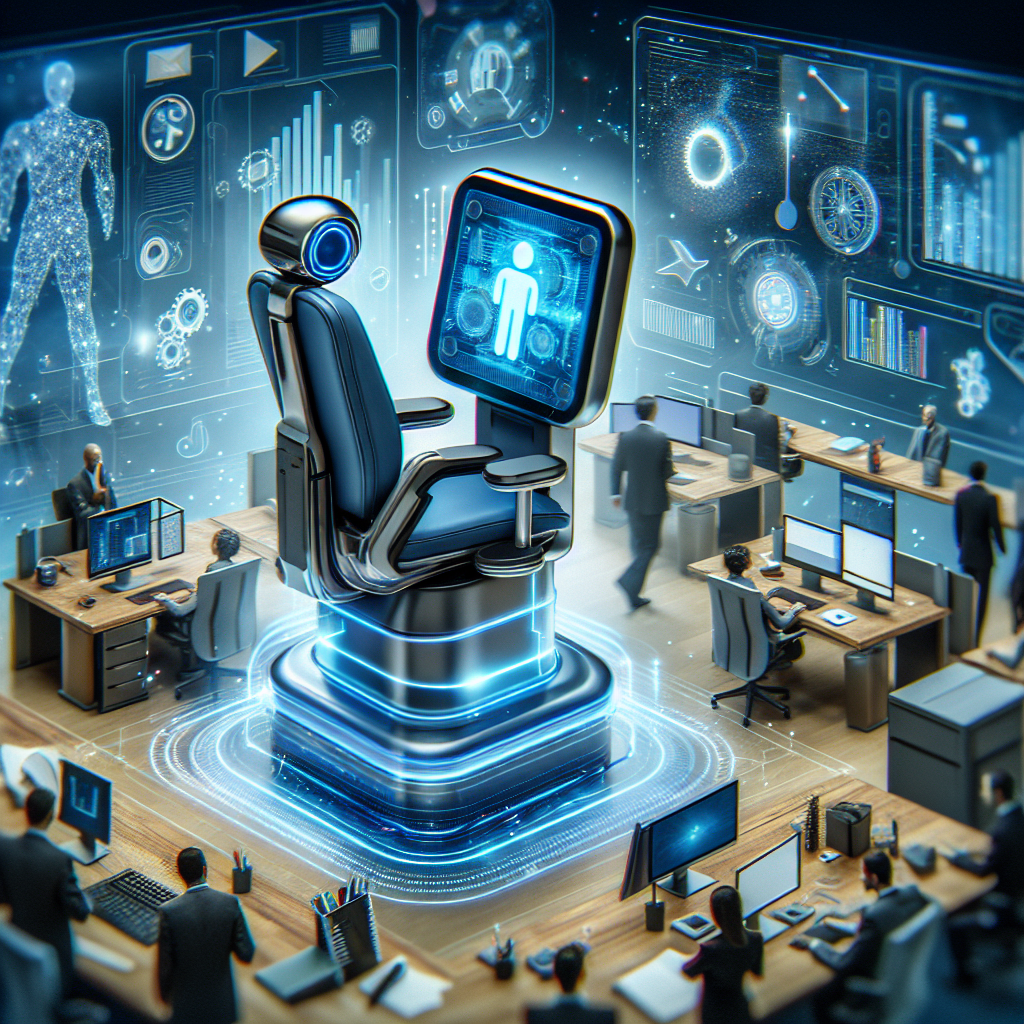Imagine a workspace that adapts to your needs, anticipates your desires, and revolutionizes productivity. Welcome to the future of smart office essentials. From AI-powered virtual assistants that seamlessly manage your schedule to biometric security systems that keep sensitive information locked away, the office of tomorrow is shaping up to be a game-changer. In this article, we will explore the latest developments in smart office technology and how they are reshaping the way we work, collaborate, and thrive in the modern workplace. So, fasten your seatbelts and get ready to experience the magnificent possibilities that lie ahead.
Automation and Artificial Intelligence
Increasing Efficiency and Productivity
Automation and Artificial Intelligence (AI) are revolutionizing the way offices operate, providing countless benefits that enhance efficiency and productivity. With automation, repetitive and time-consuming tasks can be streamlined and completed in a fraction of the time, allowing employees to focus on more value-added work. AI-powered tools can analyze vast amounts of data, identifying patterns and trends that humans may overlook, leading to more informed decision-making processes and improved business outcomes.
Enhancing Decision Making
AI algorithms and machine learning capabilities enable businesses to make well-informed decisions based on real-time data analysis. By automating data collection and analysis, AI supports decision-making processes and eliminates the guesswork involved in traditional methods. This leads to more accurate insights, enabling companies to stay ahead of competition and make data-driven strategies.
Streamlining Administrative Tasks
Administrative tasks are an essential but time-consuming aspect of running an office. However, with the help of automation and AI, these administrative tasks can be streamlined and simplified. From managing appointments and scheduling meetings to organizing and responding to emails, AI-powered virtual assistants can handle these mundane tasks, allowing employees more time to focus on strategic and creative work. Automation also reduces the risk of errors and ensures tasks are completed promptly and accurately.
Internet of Things (IoT)
Seamless Connectivity and Integration
The Internet of Things (IoT) enables various devices and equipment within an office to be connected and interact seamlessly. IoT devices can be integrated to create a smart network that enhances communication and collaboration. For example, IoT-enabled devices such as smart whiteboards can sync with laptops and smartphones, making it easier for teams to collaborate and share information in real-time. This seamless connectivity between devices not only promotes efficiency but also increases productivity by eliminating the need for manual data transfer.
Real-time Monitoring and Control
IoT devices allow for real-time monitoring and control of various aspects within the office. For instance, smart sensors can track and analyze data on temperature, lighting, and energy consumption, providing valuable insights on usage patterns and optimizing resource allocation. With this information, businesses can make data-driven decisions to improve operational efficiency, reduce costs, and minimize their environmental impact.
Energy Efficiency and Sustainability
By utilizing IoT devices, offices can significantly improve energy efficiency and contribute to sustainability efforts. Smart lighting systems, for example, can adjust illumination levels based on occupancy and ambient lighting conditions, leading to significant energy savings. Additionally, IoT-enabled sensors can monitor energy consumption across different office equipment, allowing businesses to identify areas for improvement and implement energy-saving strategies. These eco-friendly initiatives not only benefit the environment but also result in cost savings for the company.

Augmented Reality (AR) and Virtual Reality (VR)
Collaborative Workspaces
Augmented Reality (AR) and Virtual Reality (VR) technologies create collaborative workspaces that transcend geographical boundaries. Through these immersive technologies, teams can collaborate in real-time, share ideas, and work together as if they were in the same physical location. This fosters a sense of shared presence and promotes collaboration, regardless of where team members are located. With AR and VR, companies can tap into global talent pools, break down barriers, and foster innovation and creativity in the workplace.
Enhanced Training and Simulation
AR and VR offer innovative ways to train employees, providing immersive and interactive learning experiences. Whether it’s virtual simulations, 3D models, or interactive tutorials, these technologies enable individuals to learn and practice new skills in a safe and controlled environment. This eliminates the need for physical equipment and ensures consistent training experiences for all employees. AR and VR also allow for remote and flexible training, reducing travel costs and time away from the office while providing valuable and engaging learning opportunities.
Improved Customer Engagement
AR and VR technologies have the potential to transform customer engagement and enhance the overall customer experience. Companies can create immersive experiences that allow customers to visualize products or services before making a purchase, leading to increased satisfaction and reduced returns. In addition, AR and VR can be utilized for virtual product demonstrations or virtual tours, providing customers with an interactive and personalized experience. These technologies not only impress customers but also differentiate businesses from their competitors, leading to increased brand loyalty and customer retention.
Voice-controlled Technology
Hands-free Operation
Voice-controlled technology is revolutionizing the way we interact with our office environment. With voice-activated assistants such as Amazon’s Alexa or Apple’s Siri, employees can perform various tasks without the need for manual input. From scheduling meetings to setting reminders and controlling smart devices, voice-controlled technology allows for hands-free operation, increasing efficiency and productivity. Additionally, voice commands enable multitasking, as employees can perform tasks while keeping their hands and eyes focused on other activities.
Personalized Experiences
Voice-controlled technology can provide personalized experiences tailored to individual preferences. By recognizing and adapting to specific voices and speech patterns, voice assistants can provide customized recommendations, reminders, and assistance based on each user’s needs. This personalization enhances user satisfaction and productivity, as employees can efficiently access the information or resources they require without navigating through complex menus or interfaces.
Voice-based Data Analysis
The use of voice-controlled technology in data analysis is gaining prominence, allowing for quick and efficient information retrieval. Employees can request specific data points or perform complex queries using natural language, significantly speeding up the analysis process. Voice-based data analysis also reduces the learning curve for employees, as it eliminates the need to master complex data analysis tools or coding languages. This accessibility democratizes data analysis and empowers employees at all levels to make data-driven decisions.

Smart Office Security
Biometric Access Control
Smart office security systems utilize biometric technology to provide secure and convenient access control. Instead of traditional key cards or passwords, employees can use fingerprint or facial recognition to access restricted areas. Biometric access control systems enhance security by minimizing the risk of unauthorized access and identity theft. They also eliminate the need for employees to remember and carry physical access cards, streamlining the entry process and improving overall efficiency.
Video Surveillance System
Video surveillance systems have become an integral component of office security. With the advancement of AI and facial recognition technologies, these systems can identify suspicious behavior in real-time and trigger alerts for further investigation. Additionally, video surveillance systems provide a deterrent effect, discouraging potential criminals from engaging in illegal activities within the office premises. The availability of recorded footage also helps in investigations and can be used as evidence if necessary.
Cybersecurity Measures
In an increasingly digital world, cybersecurity is a top concern for businesses. Smart office security systems incorporate robust cybersecurity measures to protect sensitive data and prevent unauthorized access. This includes secure network protocols, encryption, and regular software updates to address emerging threats. By adopting comprehensive cybersecurity measures, businesses can safeguard their intellectual property, customer data, and other sensitive information, ensuring the trust and confidence of their clients.
Data Analytics and Business Intelligence
Predictive Analysis
Data analytics and business intelligence tools enable organizations to gain valuable insights from vast amounts of data. By leveraging predictive analysis, businesses can forecast future trends, customer behavior, and market demands, enabling them to make proactive and strategic decisions. Predictive analysis identifies patterns and correlations within data sets, empowering businesses to optimize operations, identify potential risks, and seize new opportunities.
Real-time Reporting and Dashboards
Real-time reporting and dashboards allow businesses to monitor and track key performance indicators (KPIs) continuously. With up-to-date data presented in visually appealing formats, decision-makers can make informed choices in a timely manner. Real-time reporting facilitates agile decision-making, enabling businesses to respond quickly to market changes or emerging trends. Dashboards provide a comprehensive overview of business performance, empowering employees at all levels to understand their contributions towards achieving organizational goals.
Enhanced Strategic Decision Making
Data analytics and business intelligence enable evidence-based decision-making, ensuring that strategic choices are grounded in accurate and reliable data. These tools allow businesses to analyze operational and financial performance, identify areas for improvement, and align strategies with organizational goals. By providing comprehensive insights into market dynamics, customer behavior, and industry trends, data analytics and business intelligence empower businesses to stay ahead of the competition and make proactive decisions for sustainable growth.
Cloud Computing
Scalability and Flexibility
Cloud computing offers scalability and flexibility, allowing businesses to adapt and grow without the need for significant infrastructure investments. With cloud-based services, companies can easily scale up or down their resources based on demand, ensuring optimal performance and cost-efficiency. This scalability eliminates the need to provision and maintain on-premises servers, reducing the burden on IT teams and enabling businesses to focus on their core operations.
Collaboration and Workflow Optimization
Cloud computing enables seamless collaboration and workflow optimization by providing a centralized platform for file sharing, document collaboration, and project management. With cloud-based productivity tools, teams can work together in real-time, regardless of their physical location. This enhances communication, increases productivity, and facilitates efficient collaboration between employees, departments, and even external stakeholders. Cloud-based collaboration tools also eliminate version control issues and ensure that everyone has access to the latest documents and files.
Disaster Recovery and Data Backup
Cloud computing provides businesses with robust disaster recovery and data backup solutions. Instead of relying on traditional backup methods, which can be time-consuming and prone to errors, businesses can rely on cloud-based backups for seamless data recovery in the event of a disaster. Cloud storage also protects against physical damage to on-premises infrastructure, ensuring that critical business information remains safe and accessible.
Remote and Flexible Work
Virtual Meetings and Communication
Remote work has become increasingly prevalent, and virtual meetings and communication tools have become essential for businesses. With video conferencing platforms and collaboration software, teams can connect and collaborate regardless of their physical location. Virtual meetings enable face-to-face communication, facilitate real-time decision-making, and foster a sense of team cohesion. These tools also reduce travel costs, save time, and enable businesses to tap into global talent pools for increased diversity and skill sets.
Independent Worker Productivity
Remote work and flexible work arrangements have been shown to increase independent worker productivity. By eliminating distractions inherent to traditional office environments, employees can focus on their work and accomplish tasks more efficiently. Flexible work schedules and the ability to work from anywhere also promote a better work-life balance, resulting in higher job satisfaction and retention. Additionally, remote work allows businesses to tap into a wider talent pool, as location is no longer a constraint for hiring top talent.
Work-life Balance
The flexibility offered by remote and flexible work arrangements promotes a healthier work-life balance. Employees have greater control over their schedules, allowing them to attend to personal commitments without sacrificing productivity. This flexibility reduces stress, improves mental well-being, and contributes to higher employee satisfaction. By prioritizing work-life balance, companies can attract and retain top talent, create a positive work culture, and foster a more engaged and motivated workforce.
Sustainable and Eco-friendly Solutions
Energy Management and Conservation
Smart office technology plays a crucial role in energy management and conservation efforts. By integrating energy monitoring systems, businesses can identify energy consumption patterns and implement energy-saving measures. Smart thermostats, automated lighting, and energy-efficient equipment all contribute to reducing energy waste and lowering carbon footprints. Not only do these initiatives help protect the environment, but they also result in substantial cost savings for businesses over the long term.
Waste Reduction and Recycling
Efforts to minimize waste generation and promote recycling are essential for sustainable office environments. Smart office solutions can help identify waste generation sources and implement strategies to reduce waste. This includes using smart sensors to optimize resource consumption, enabling paperless workflows, and implementing recycling programs. By adopting eco-friendly practices, businesses can reduce their environmental impact and contribute to a more sustainable future.
Green Building Design
Smart office technology, coupled with green building design principles, can significantly reduce energy consumption and enhance sustainability. Technologies such as energy-efficient HVAC systems, natural lighting optimization, and rainwater harvesting systems contribute to reducing environmental impact. Smart sensors and automation further optimize resource utilization, resulting in more efficient and eco-friendly office spaces. Green building designs not only benefit the environment but also create healthier and more comfortable work environments for employees, improving productivity and well-being.
Smarter Office Furniture and Layouts
Ergonomics and Employee Well-being
Smarter office furniture considers ergonomics and employee well-being. Adjustable standing desks, ergonomic chairs, and monitor arms promote proper posture, reducing the risk of musculoskeletal issues and increasing employee comfort. Smart furniture can incorporate health-tracking sensors, reminding employees to take breaks, stretch, or adjust their postures for optimal health. By prioritizing employee well-being, businesses can reduce work-related injuries, increase productivity, and create a positive work environment.
Space Optimization and Utilization
Smarter office layouts and furniture solutions optimize space utilization, ensuring that every square foot is used efficiently. By utilizing modular furniture and flexible workspace designs, businesses can easily adapt to changing needs and accommodate future growth. IoT-enabled occupancy sensors provide valuable insights into space utilization trends, allowing companies to optimize their office layouts, reduce unused spaces, and allocate resources effectively.
Modular and Customizable Furniture
Modular and customizable furniture solutions allow businesses to create flexible and adaptable work environments. With modular furniture, companies can easily reconfigure their office spaces to accommodate different team sizes or changing work requirements. Customizable furniture solutions enable employees to personalize their workstations based on their individual needs and preferences. These flexible and versatile furniture options enhance employee satisfaction, promote creativity, and facilitate collaboration by providing tailor-made work environments.

